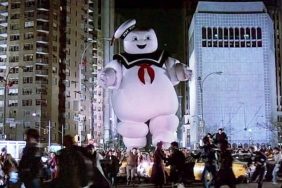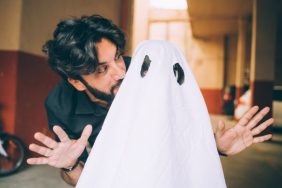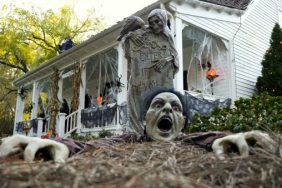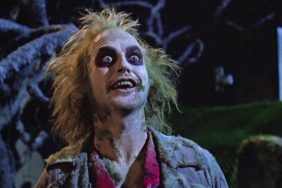You know exactly who Dean Cundey is, but maybe you don’t know his name. Dean Cundey was the director of photography on Jurassic Park. He was the director of photography on the Back to the Future trilogy. He was the director of photography on Apollo 13. And he worked on a particularly long series of films with John Carpenter, including Big Trouble in Little China, The Thing, Escape from New York, The Fog and Halloween. That last film is particularly appropriate, as it’s Halloween today, and the 35th anniversary edition Blu-ray release is in stores now.
We’ve already talked to Halloween star P.J. Soles and director John Carpenter this month, so I’m especially proud to bring you my conversation with Dean Cundey about the film’s groundbreaking cinematography, the two sequels he also shot, and his impressive career behind the camera.
CraveOnline: At the time when you made Halloween you were making a lot of exploitation films. Did Halloween seem like a film that would break out, or was it just another project at the time?
Dean Cundey: You know, there was just something that surrounded it. I know meeting John [Carpenter] for the first time… Debra Hill had worked on a couple of the films that I had worked on previously, and suggested that I meet him because she thought we’d make a good team. There was just something about John that said he was a little more serious a filmmaker than some of the other guys I had worked with who were making a product. I knew John wanted to make something, at least I felt he wanted to make something that was a little more quality, even for the subject matter. I have to say that doing Halloween we all felt that there was something just a little bit elevated about it compared to just your exploitation films.

I’ve read a lot of John Carpenter’s interviews, and when he talks about Halloween, it sounds like he’s obsessed with the panaglide.
Well, I have to say it was a new device at the time. It had barely been used, I think [in] three or four movies. Two that I had seen it on. When it was introduced to me it was obviously a very unique device, and it allowed you to move the camera in a way that hadn’t been possible before. Not only mechanically, but subjectively. It was a floating, moving entity, sort of. I know that when we tried it out on Halloween it became pretty evident that it was a unique device, and as such we tried to apply it in a unique way. Not just to replace a dolly or anything with a moving camera. We tried to let it become a character itself, becoming the point of view of Michael Myers, or any time we saw him the panaglide represented his presence. It was really kind of a unique use of a unique piece of equipment.

How difficult was it to pull off the opening shot, from Michael Myers’ P.O.V.? It seems like such a small-scale production. How hard was it to prep that and get it right?
Well, it was pretty tricky because as far as we knew nobody had used the panaglide, the camera in that way, to track through a house. It had been used to follow David Carradine in Bound for Glory, the refugee camp and stuff, but as a kind of character it hadn’t been used. I know that for John and I, we wanted to really make that a significant shot, a significant use of the camera. So I was very pleased when they had dedicated, essentially, half a day to that one shot. We had very few days – 20 some days, I think we had – for the whole movie, which is not a lot to make a movie, to be dedicated to making it a significant shot, to the extent that we had probably half a day to do it was really pretty bold.
So it was actually pretty tricky, because like I said, nobody had done it, so we were pioneering it, as far as the camera moving through the house, looking through the window, and then moving eventually through the kitchen and into that same room, it was a case of lighting the room through the window and then when we were moving around towards the back of the house, guys were moving lights and putting new ones up so they wouldn’t be seen by the camera. So it was a very choreographed shot, which took us the better part of a day to prepare for it – rehearsing and setting lights and everything – and it took several takes in order to get it right.

The whole film feels very meticulously framed, particularly once the murders begin. It feels like every wide shot has negative space, or a doorway in the background and you’re just waiting for Michael Myers to pop into it. Were those all planned, or am I being a pretentious film critic?
No, I don’t mind pretentious film critics when it makes us look like geniuses, but I have to say it was carefully planned. John and I talked about composition and how to not only not only make dark areas red herring areas to keep the audience on edge, but also to use it for the actual scares. I think that’s one of the things I appreciated about making the film, was that we actually put thought and attention into the compositions. The camera wasn’t just used to record actors standing and talking, or something blowing up or whatever. For me, and for us, it was a unique opportunity to be thoughtful about the compositions and how to use that very wide frame.

Was there ever any disagreement, or frustration with the shooting schedule, that led to scenes you would have liked to have more time with or done differently?
Well, you know, looking back on it… Because I watched the movie again as I was preparing this 35th[Anniversary] Blu-ray disc, but you always are a little frustrated by the fact that you wished you had a little more time. Sometimes it’s only an hour or two in a day. Sometimes in a big sequence you wished you had another day or two. I just finished a movie not too long ago that really needed about two more weeks in order to make it really work, instead of four weeks we could have used six. So I have to say that Halloween was the same. When we were working, it’s always lighting a shot and wishing we could do one more camera angle. I have to say, John was very bold in sparsely using the number of angles and takes, because he knew was going to have to dedicate time to certain sequences, so some [other] scenes just take place in one or two shots.

When Jamie Lee Curtis walks across the street – I realize some of this is editing – but it feels very measured, like you’re allowing it to take as much time as possible. Was the original idea to milk the suspense for that? Were you ever tempted to say, “Hey, could you walk faster?”
I have to say that it was a very thoughtful approach to building the suspense, and to revealing the scares. So we knew that if you shoot it slow, you can speed it up in the editing. You can make it shorter. But you can’t always make it longer. If the scene needs to be longer you just allow for that when you shoot it. I have to say that that’s probably evident in several of those places, where we would shoot several angles of the same action so that it could be expanded or contracted.






